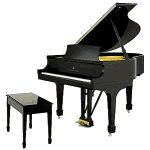

Choose the letter which begins musical term that you would like to learn about:
| A | B | C | D | E | F | G | H | I | J | K | L | M | N | O | P | Q | R | S | T | U | V | W | X | Y | Z |
DSecond note of the C major scale. An abbreviation for da, dal or destra.
Da capo, D. C.Return to the beginning.
Dal"From the," "by the."
Dal segno, D. S.Repeat from the sign. Frequently followed by al Fine.
Dal segno al FineRepeat from the sign. Then end at the word Fine.
DampStop the sound.
Damper pedalOn pianos, the pedal on the right side. It lifts the dampers from the strings.
D durKey of D major.
Deceptive cadenceChordal progression dominant (V) to a chord other than the expected tonic.
DecrescendoGradually softer. Synonymous with diminuendo.
DegreeOne of the eight consecutive tones in a major or minor scale.
DelicatoDelicately.
DestraRight, right hand.
DiOf, with.
DiminishedThe term for an interval which has been decreased from the major by two half steps and from the perfect by one half step, e.g. c-a, diminished sixth, or c-g
, a diminished fifth. Also used for a triad which has a minor third and a diminished fifth, e.g. c
, c-e
, g
.
Diminuendo, dimGradually softer. Synonymous with decrescendo.
DiminutionThe shortening of note values; the opposite of augmentation.
DirgeA piece that is performed at a funeral or memorial service.
DisjunctThe term used to describe intervals larger than a second; the opposite of conjunct.
DissonanceSounds of unrest, e.g. intervals of seconds and sevenths; the opposite of consonance.
Divisi, divAn indication of divided musical parts.
D molKey of D minor.
DoThe first degree of the major scale.
DolceSweetly.
DolcissimoVery sweetly.
DolorosoSadly; mournfully.
DominantThe fifth degree of the major or minor scale. Also, the term for the triad built on the fifth degree, labelled V in harmonic analysis.
Dotted NotesA dot (.) placed to the right of any note increases the value of that note by half the original value.
In 4/4 time:
is equal to 3 quarters of a beat or plus a is equal to one and a half beats or plus an is equal to three counts or plus a
Double barTwo vertical lines placed on the staff to indicate the end of a section or a composition. Also, used with two dots to enclose repeated sections.
Double flatA symbol for lowering pitch one step.
Double sharpA symbol for raising pitch one step.
Double tonguingOn flute and brass instruments, the technique of rapidly articulating notes by using the front and the back of the tongue in alternation (t-k-t-k-t-k).
Down beatThe first beat; given by the conductor with a downward stroke.
Down bowIn the violin family, drawing the bow downward from its frog.
Du"From the," "of the."
DuetA piece for two performers.
DupletA group of two notes performed in the time of three of the same kind.
DynamicsVarying degrees of loud and soft.

A B C D E F G H I J K L M N O P Q R S T U V W X Y Z
Some definitions and terms excerpted from
Belwin Pocket Dictionary of Music: Music Theory Dictionary
By Dr. William Lee
Students may purchase a copy for home use at cost
Many thanks to Dearest for everything!
is located
in Fairfax, Virginia
Over 30 Years
~~
Piano, Organ
Electric Keyboard
Accompanying
All rights reserved.
Site design and maintenance by
O'Connor O'Riginals Web Design
